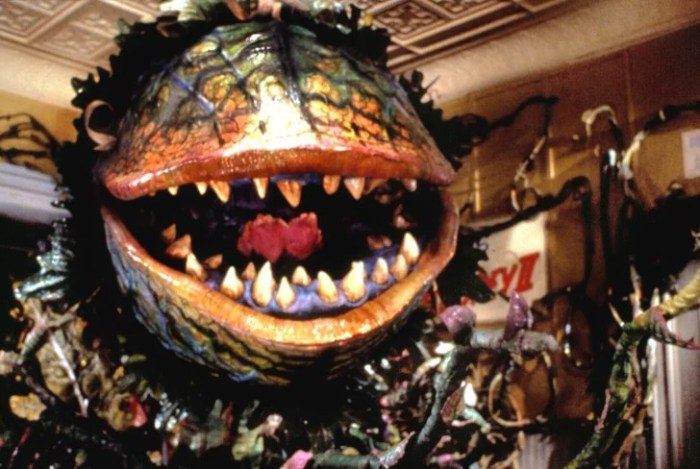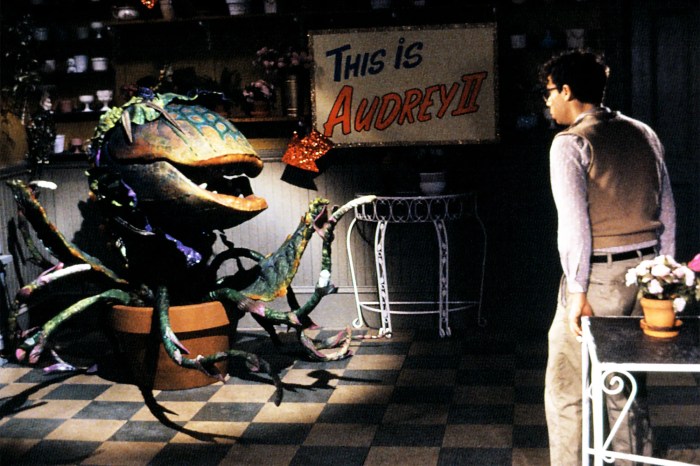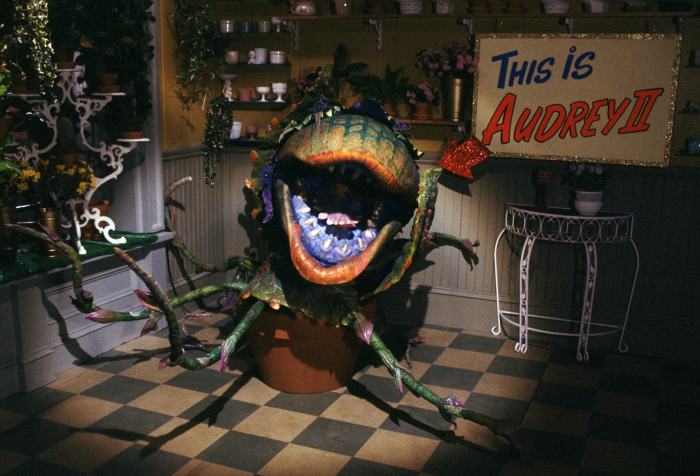Little Shop of Horrors trivia takes us on a fascinating journey behind the scenes of this beloved musical, revealing intriguing facts and anecdotes that will delight fans and enthusiasts alike. From the origins and development of the show to the iconic songs and characters, we’ll delve into the captivating world of Little Shop of Horrors, uncovering its secrets and celebrating its enduring legacy.
Get ready to be entertained as we explore the challenges and triumphs faced during the development process, discover the creative team behind the musical and their contributions, and gain insights into the rehearsals and backstage experiences.
Little Shop of Horrors Synopsis
Little Shop of Horrors is a musical comedy that tells the story of Seymour Krelborn, a nerdy and insecure florist assistant. Seymour’s life takes a bizarre turn when he discovers a strange and exotic plant in a local flower shop.
The plant, which he names Audrey II, has an insatiable appetite for human blood and quickly becomes a sensation.
As Audrey II grows larger and more powerful, Seymour’s ambition and greed begin to consume him. He becomes entangled in a web of lies and deceit as he tries to keep the plant’s true nature a secret. The musical explores themes of love, morality, and the consequences of unchecked desire.
Main Characters
- Seymour Krelborn: A nerdy and insecure florist assistant who discovers Audrey II.
- Audrey Fulquard: A beautiful and kind-hearted co-worker of Seymour’s.
- Audrey II: A carnivorous plant that feeds on human blood.
- Orin Scrivello: A sadistic dentist who is Audrey’s abusive boyfriend.
- Mr. Mushnik: The owner of the flower shop where Seymour works.
Themes and Central Message
Little Shop of Horrors explores several themes, including:
- The dangers of unchecked ambition: Seymour’s desire for fame and fortune ultimately leads to his downfall.
- The importance of love and compassion: Audrey’s love for Seymour helps him to see the error of his ways.
- The consequences of ignoring one’s conscience: Seymour’s decision to feed Audrey II human blood leads to a series of tragic events.
The musical’s central message is that unchecked ambition and greed can lead to disastrous consequences.
Did you know that in the musical “Little Shop of Horrors,” the plant Audrey II is actually a carnivorous plant? It’s true! And speaking of plants, have you ever wondered about the fascinating process of cell division? Check out this helpful resource on diagrama de mitosis y meiosis to learn more about the wonders of biology.
Back to “Little Shop of Horrors,” did you know that the movie’s budget was only $2.5 million? Talk about a box office success!
Origins and Development
The origins of Little Shop of Horrors can be traced back to 1960, when director Roger Corman approached screenwriter Charles B. Griffith to create a low-budget science fiction horror film. Griffith developed the story of a hapless florist who discovers a mysterious plant that grows and thrives on human blood.The
film, titled The Little Shop of Horrors, was released in 1960 and became a cult classic. In the 1970s, a stage adaptation of the film was created by Howard Ashman and Alan Menken, who expanded the story and added several new songs.The
musical premiered off-Broadway in 1982 and was a critical and commercial success. It transferred to Broadway in 1983 and ran for over two years. The musical has since been revived several times, including a successful Broadway revival in 2003.
Creative Team
The creative team behind Little Shop of Horrors included:
- Howard Ashman (book and lyrics)
- Alan Menken (music)
- Frank Oz (director)
- Jerry Zaks (choreographer)
- Martin P. Robinson (scenic designer)
- William Ivey Long (costume designer)
Challenges and Triumphs
The development of Little Shop of Horrors was not without its challenges. The musical’s dark and satirical themes were not initially embraced by all audiences, and the production faced financial difficulties during its early years.However, the musical’s creators persevered, and Little Shop of Horrors eventually became one of the most beloved musicals of all time.
The musical has been praised for its clever lyrics, catchy songs, and memorable characters. It has also been lauded for its ability to both entertain and provoke thought.
Cast and Characters

The cast of Little Shop of Horrors features a memorable ensemble of characters, each bringing their own unique personality and relationships to the story.
The casting process involved a rigorous search for actors who could not only capture the essence of the characters but also possess exceptional singing and comedic abilities.
Main Cast and Characters
| Actor | Character |
|---|---|
| Rick Moranis | Seymour Krelborn |
| Ellen Greene | Audrey Fulquard |
| Vincent Gardenia | Mr. Mushnik |
| Levi Stubbs | Audrey II (voice) |
| Tichina Arnold | Crystal |
| Michelle Weeks | Ronette |
| Sheila Kay Davis | Chiffon |
Seymour Krelbornis a shy and awkward florist who becomes the unwitting caretaker of Audrey II, a mysterious and carnivorous plant. Rick Moranis’s portrayal captures Seymour’s vulnerability, his desire for love and acceptance, and his gradual transformation as he becomes increasingly obsessed with Audrey II.
Audrey Fulquardis the beautiful and kind-hearted love interest of Seymour. Ellen Greene’s performance exudes Audrey’s innocence, her resilience, and her unwavering belief in the good in people.
Mr. Mushnikis Seymour’s greedy and eccentric boss at the flower shop. Vincent Gardenia’s portrayal is a comedic masterpiece, capturing Mr. Mushnik’s penny-pinching ways, his constant fear of failure, and his deep-seated loneliness.
Audrey IIis the enigmatic and bloodthirsty plant that becomes Seymour’s downfall. Levi Stubbs’s booming voice provides the plant with an imposing and seductive presence, while the puppeteers bring Audrey II to life with incredible dexterity and expression.
The supporting cast of Crystal, Ronette, and Chiffon, played by Tichina Arnold, Michelle Weeks, and Sheila Kay Davis, respectively, adds humor and warmth to the story. Their energetic performances and soulful vocals create a vibrant and memorable ensemble.
Cultural Impact
Little Shop of Horrors has enjoyed both critical and commercial success since its debut.
The musical has received numerous awards, including five Tony Awards, two Grammy Awards, and a Pulitzer Prize for Drama. It has been translated into over 30 languages and has been performed in over 50 countries.
Impact on Popular Culture
Little Shop of Horrors has had a significant impact on popular culture. The musical’s songs, such as “Skid Row (Downtown)” and “Suddenly, Seymour,” have become popular standards.
The musical has also been parodied and referenced in numerous other works of popular culture, including the films The Simpsons and South Park.
Legacy in the Theater World
Little Shop of Horrors is considered to be one of the most important musicals of the 20th century.
The musical has been praised for its innovative use of puppetry and its dark humor. It has also been credited with helping to revive the off-Broadway theater scene in the 1980s.
Adaptations and Revivals
Little Shop of Horrors has been adapted into several films, including a 1986 version directed by Frank Oz and a 2019 version directed by Greg Berlanti.
The musical has also been revived several times on Broadway, most recently in 2019. The 2019 revival was nominated for three Tony Awards, including Best Musical Revival.
Behind-the-Scenes Trivia: Little Shop Of Horrors Trivia

The production of Little Shop of Horrors was filled with interesting anecdotes and challenges. Here are some intriguing facts about the making of this beloved musical:
Special Effects and Props
- The giant Audrey II puppet was a marvel of engineering. It weighed over 500 pounds and required a team of puppeteers to operate its intricate movements and expressions.
- The blood used in the show was actually strawberry jam, creating a sticky and realistic effect.
- The Skid Row denizens’ costumes were designed to reflect their poverty and desperation, with torn clothes and mismatched shoes.
Rehearsals and Backstage Experiences, Little shop of horrors trivia
The rehearsals for Little Shop of Horrors were intense and demanding. The cast and crew spent countless hours perfecting the show’s intricate musical numbers and comedic timing.
- The cast would often break into spontaneous singing and dancing during rehearsals, creating a lively and energetic atmosphere.
- The backstage area was a hub of activity, with puppeteers coordinating the movements of Audrey II and the actors preparing for their performances.
- The show’s success led to a number of cast members being nominated for Tony Awards, including Jonathan Hadary for Best Featured Actor in a Musical.
Plant Life

The plant Audrey II is the central and most significant element in the musical Little Shop of Horrors. It is a carnivorous plant that feeds on human blood and grows to enormous proportions. Audrey II represents the dangers of unchecked desire and the corrupting influence of power.
The design and creation of the plant puppet was a complex and challenging process. The puppet was made of a variety of materials, including foam rubber, latex, and metal. It was operated by a team of puppeteers who used a combination of rods, strings, and hydraulics to bring the plant to life.
Symbolism and Metaphors
Audrey II is a powerful symbol of the dangers of unchecked desire. The plant’s insatiable hunger for blood represents the way that our own desires can consume us and lead us to do terrible things. The plant’s rapid growth and its ability to control Seymour also represent the way that power can corrupt and destroy.
Themes and Symbolism

At its core, Little Shop of Horrors explores universal themes of love, obsession, and morality. These themes are embodied through the characters and plot devices, while symbolism and imagery enhance their impact.
Love and Obsession
- Seymour’s love for Audrey becomes an unhealthy obsession, leading him to make dangerous choices.
- Audrey’s vulnerability and desire for acceptance make her susceptible to Seymour’s manipulation.
- The plant, Audrey II, represents the destructive nature of obsession, growing stronger as Seymour sacrifices more for it.
Morality
- Seymour’s descent into darkness challenges the boundaries of morality as he justifies his actions for the sake of love.
- Audrey’s struggle to break free from her abusive relationship with Orin highlights the complexities of morality and choice.
- The musical raises questions about the consequences of unchecked ambition and the responsibility that comes with power.
Symbolism and Imagery
- The plant, Audrey II, is a powerful symbol of temptation and the destructive consequences of desire.
- The Skid Row setting represents the seedy underbelly of society, where desperation and poverty breed darkness.
- The musical’s use of black humor and campy elements highlights the contrast between the horrific events and the characters’ naivete.
FAQs
What is the significance of the plant Audrey II in Little Shop of Horrors?
Audrey II represents temptation, greed, and the corrupting power of desire. It feeds on blood and grows stronger with each victim, symbolizing the destructive nature of unchecked ambition.
What are some interesting facts about the production of Little Shop of Horrors?
The original plant puppet was made of foam rubber and latex and weighed over 500 pounds. It was operated by a team of puppeteers who had to be hidden beneath the stage.
What are the major themes explored in Little Shop of Horrors?
The musical explores themes of love, obsession, morality, and the consequences of unchecked ambition. It also examines the darker side of human nature and the dangers of succumbing to temptation.